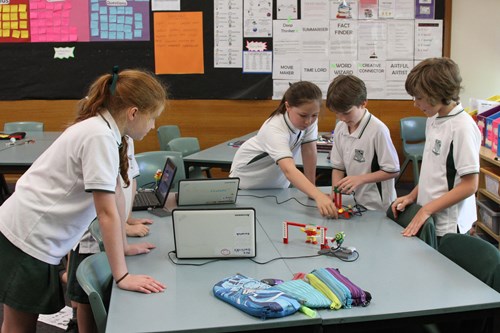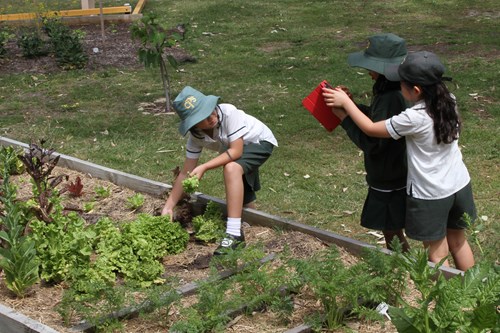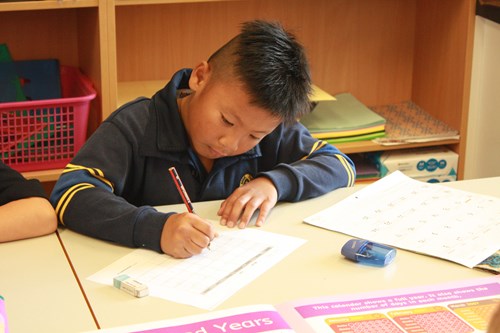Young people need more than subject knowledge in order to thrive in today’s rapidly changing landscape, says Manly West Public School Instructional Leader Sara Lind.
 As a learner and an educator, I am committed to developing future-focused learners who are twenty-first century capable, with the skills, capabilities and character attributes necessary to thrive beyond the classroom. I advocate an educational approach that is authentic and student centred, empowering students to think for themselves and develop as creative and critical thinkers.
As a learner and an educator, I am committed to developing future-focused learners who are twenty-first century capable, with the skills, capabilities and character attributes necessary to thrive beyond the classroom. I advocate an educational approach that is authentic and student centred, empowering students to think for themselves and develop as creative and critical thinkers.
As an instructional leader, I provide professional learning for teachers, which empowers and values their creativity and professionalism, and promotes the highest quality of teaching and learning environment, where leaders and teachers work together to maximise the effect of their teaching to achieve the best outcomes for learners.
A learning journey
Teachers at Manly West Public School in New South Wales have started to develop their understanding of the general capabilities to increase the quality of program design and teaching, and to ensure our students are equipped with twenty-first century skills. It forms a part of the school’s strategic direction in its three-year plan, Strong, Quality Foundations for 21st Century Learners. In my role as instructional leader, I have been leading this initiative, working alongside teachers at the school to examine the current research behind the general capabilities. Building a deep understanding of the general capabilities through research and evidence-based practice is an essential process to highlight their significance and propensity to build teacher capacity.
With changes to the landscape of education, teachers at Manly West Public School are learning to consider the general capabilities as part of their program and how students acquire the content of the learning the subjects. Staff have engaged in regular professional learning sessions, based on the research of education pioneers including Professor Bill Lucas, Carol Dweck, Charles Fadel, Charles Leadbeater and James Phelps. During these sessions, teachers have examined global school models, where the general capabilities and school-determined dispositions have been successfully embedded. These models include Thomas Tallis School, London Fields, British Columbia, Alberta Education and Brunswick East Public School. Our teachers have begun to use the dispositions of flexibility, persistence and open-mindedness to build their roles. The school culture that promotes ongoing reflection and the mindset of ubiquitous learning is supporting teachers as they continuously strive for improved professional practice.
The most challenging part of this process for teachers has been to transfer their knowledge and understanding of the general capabilities into programming and classroom practice. Initially, to support teacher understanding, I led staff to focus on various thinking and learning dispositions, key components of the general capabilities. We started by focusing on the learning dispositions outlined by educator and founder of Minds Wide Open, James Phelps. These dispositions included: Open-minded, Flexible, Risk-taker, Resourceful, Patient and Persistent, Ubiquitous Learner and Reflective. In groups, teachers focused on one of the dispositions and collaboratively wrote a description of what this disposition looked like for a teacher. Teachers were provided with opportunities to reflect on their own professional practice using the dispositions. As part of our three-year school plan, we will be embedding the dispositions school wide, with our goal to then incorporate these into reports to parents. The dispositions are also being embedded into the way we deliver our current student welfare program, BounceBack!
Teacher professional learning sessions to build staff capacity around the general capabilities, with a particular focus on critical and creative thinking, have also involved:
- Teachers were mixed across grades, with each group allocated a learning area. Groups were given time to read through the Australian Curriculum general capabilities continua and support materials, describing what each of the seven capabilities ‘looks like’ in that learning area. Each group decoded, summarised and recorded this information, focusing on key verbs, and discussed and noted examples of how teachers were achieving this in classrooms.
- Visible Learning. Staff were supported in using the Critical and Creative Thinking (CCT) learning continuum to look through a grade literacy or history program and find evidence of where Critical and Creative Thinking elements were included. This process allowed teachers to reflect upon and analyse any gaps they found in their programs, where the CCT continuum elements were not addressed. This promoted further discussion amongst teams (using a shared language) around the design of teaching activities that provide our students with opportunities for critical and creative thinking. While the focus was on CCT, staff were also encouraged and supported to look for connections between their current literacy/history program and other general capabilities, particularly the Intercultural Understanding, and Personal and Social capabilities.
The goal of these sessions was to have staff working collaboratively to reimagine their current programs to ensure they included elements of the Critical and Creative Thinking capability and at least one other capability. Staff are learning to include the dispositions in learning intentions and success criteria. Staff learning will be celebrated as these programs become exemplary models, shared by teams school wide.
- Instructional Leadership. Ensuring our students are equipped with twenty-first century capabilities involves a collaborative approach to designing quality multidisciplinary learning opportunities for students. I have been working alongside Years 5 and 6 teachers to build their capacity to design quality multidisciplinary programs. These programs embed the general capabilities and add depth to student learning through, for example, the use of visual art, technologies and rich texts to explore real world events and problems. Teachers are consistently encouraged to reflect on their understanding of the capabilities and to provide opportunities for students to develop as creative and critical thinkers.
About Sara
I am an advocate for public education and I maintain strong passion for cultivating creative learning in schools. I have worked as a consultant content writer for the NSW Arts Unit and my commitment to ongoing excellence in learning, leadership and achievement has been recognised by my 2018 Executive Director’s Award, ‘Significant Contributions to Public Schools’, for the Beaches Principal Network. It is my personal passion to educate students for the twenty-first century and beyond.
 Set in the twenty-third century, Mechanica describes a time when the earth could no longer support wildlife. The text’s underlying message is clear: if we don’t adapt to live more sustainably, this could be our future.
Set in the twenty-third century, Mechanica describes a time when the earth could no longer support wildlife. The text’s underlying message is clear: if we don’t adapt to live more sustainably, this could be our future.
I have been working with Years 5 and 6 teachers and students to implement an Art of Literacy unit of work using the text Mechanica by Lance Balchin. The focus of the unit of work is on developing students’ critical and creative thinking skills using a multidisciplinary English and Visual Arts approach.
The multidisciplinary unit of work began with the study of the text’s incredible illustrations. This led to the exploration of the steampunk genre to add depth to student learning, and improved student engagement and writing outcomes. Students used Mechanica to compose their own descriptive texts that were both original and imaginative. The unit of work provided students with opportunities to increase the flexibility, fluency, originality and elaboration of their ideas in their writing and in their art-making.
During the teaching and learning experiences, students were provided with opportunities to practise their thinking skills to plan and create their own Mechanica-inspired sculptures using wire and found objects such as motherboards, wires and circuit boards. Students were encouraged to engage the dispositions of persistence, resourcefulness, flexibility, open-mindedness, risk-taking, and reflection.

The unit of work explicitly targeted making learning visible. Students clearly articulated what and how they were learning using a practised, shared language. The understanding of a shared language was supported by the use of learning intentions and success criteria, which focused on elaboration and originality. Students’ creative growth was measured using divergent thinking assessments at the beginning and the end of the unit. Student work and progress were communicated to, and well-received by, the school community.


Special events
As part of the learning experiences, Mechanica author, Lance Balchin, spent a day at Manly West working with teachers and students. He discussed the dystopian world of Mechanica, artificial intelligence, environment and technology. He further explored the art of photoshop in a smaller workshop, which provided an enriching opportunity for students to extend their ICT capabilities in art-making.

The unit of work culminated in Mechanica: The Art of Literacy exhibition, which showcased student learning and achievement. Students displayed three pieces of work: the Mechanica-inspired three-dimensional wire sculpture, a piece of descriptive writing and a lifecycle of the Mechanica-inspired creature. It was an excellent way for the school community to celebrate and share the learning and achievements of Year 5 students and their teachers.

A model of success
The Mechanica unit of work was an example of how learning the skills of critical and creative thinking can underpin student learning in all subject areas, and how effective collaboration between leaders, teachers, students and the parent community can impact on student learning. The success was demonstrated in student and teacher engagement and feedback.

Feedback identified improved confidence and ability to generate ideas, and an increase in the flexibility and originality of those ideas. Students demonstrated their capacity to transfer the skills they learnt during weekly Mechanica sessions across other learning areas. As a result, the capabilities are now incorporated into the learning intentions and success criteria of other units of work. Students and teachers now share the mindset that creativity can be taught and learnt.

Curriculum focus: general capabilities and cross-curriculum priorities in English and The Arts
Within the context of English and The Arts learning areas, the three dimensions of the Australian Curriculum were addressed through a focus on Critical and Creative Thinking capability and the cross-curriculum priority of Sustainability.
General capability: Critical and creative Thinking
|
CCT element |
Sub-element |
Key skills & learning: English and Visual Arts |
|
Inquiring, identifying, exploring and organising information and ideas element |
Pose questions
Identify and clarify information and ideas
Organise and process information |
- Explore the steampunk genre. Develop knowledge and understanding about the Industrial Revolution and its influence on art and design in the 19th century. - Make and explore the connections between the text’s illustrations, the Industrial Revolution and the steampunk art movement. - Identify and learn a range of questioning skills |
|
Generating ideas, possibilities and actions element |
Imagine possibilities and connect ideas
Consider alternatives
Seek solutions and put ideas into action |
- Increase the fluency and flexibility of ideas using the SCAMPER and Art of Brainstorming models. - Develop originality and elaboration in writing and artmaking. - Use design thinking to plan, design and create a 3D Mechanica-inspired wire sculpture that incorporates found technology. - Ask good questions. - Use technical and creative language to produce writing that is imaginative. - Take risks with ideas (risktaker) |
|
Reflecting on thinking and processes element |
Reflect on processes
Transfer knowledge into new contexts |
- Articulate what is being learnt, using a shared language. - Explain and reflect on thinking. - Use the knowledge of the Industrial Revolution to understand the steampunk genre and make connections to the illustrations in Mechanica. - Use divergent thinking tests to reflect on their creative growth and potential. - Use teacher and peer feedback to improve their work |
|
Analysing, synthesising and evaluating reasoning and procedures element |
Draw conclusions and design a course of action
Evaluate procedures and outcomes |
- Demonstrate flexibility and resourcefulness by being able to look at problems from multiple perspectives, and modify their plan when problems arise. - Improvise when resources are limited. - Use prior knowledge to evaluate the effectiveness of ideas, methods and courses of action |
Cross-curriculum priority: Sustainability
Organising idea 4: World views that recognise the dependence of living things on healthy ecosystems and value diversity and social justice are essential for achieving sustainability.
Organising idea 7: Actions for a more sustainable future reflect values of care, respect and responsibility, and require us to explore and understand environments.
|
Key questions |
Capability focus: CCT elements |
|
What is sustainability? |
Identify and clarify information and ideas |
|
What impact have the humans had on the environment? How do we know this from the text? Evaluate the benefits of this impact. Do they outweigh the problems? |
Organise and process information, apply logic and reasoning, evaluate procedures and outcomes, consider alternatives, think about thinking. |
|
How can we live more sustainably? |
Transfer knowledge into new contexts, seek solutions and put ideas into action. |
By using the Curriculum filter function on the Australian Curriculum website, you can search for the Critical and Creative Thinking general capability across year levels and learning areas?




